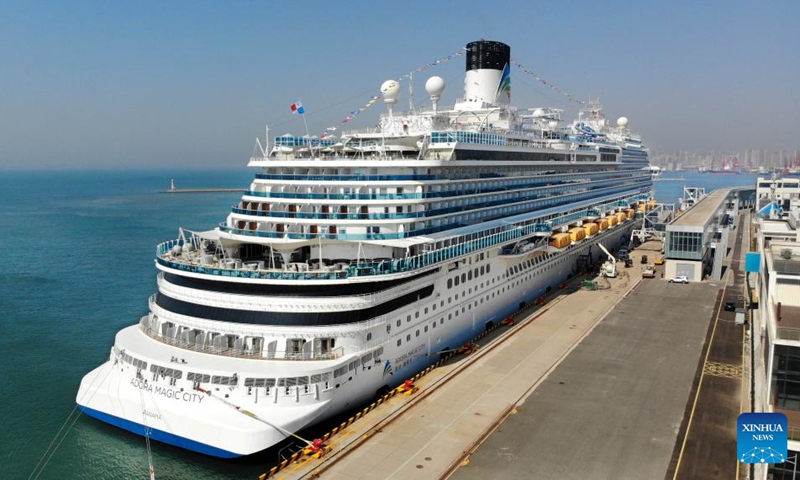
An aerial drone photo taken on April 6, 2025 shows Adora Magic City berthing at the Qingdao International Cruise Terminal in Qingdao, east China's Shandong Province. As China's first domestically built large cruise ship, Adora Magic City embarked on its commercial maiden voyage on Jan. 1, 2024. This time, the cruise ship made its debut in Qingdao, which is its first appearance in a Chinese port city other than its home port in Shanghai, and will depart for Jeju of South Korea and Fukuoka of Japan. (Xinhua/Li Ziheng)
Chinese cruise terminals have witnessed a surge in the number of inbound foreign tourists since the adoption of a visa-free entry policy a year ago, according to state broadcaster CCTV.
On May 15, 2024, China began a policy allowing visa-free entry for foreign tourist groups aboard cruise ships at all the cruise ship ports along the country's coastline, in order to promote opening-up and provide convenience for foreign tourists.
According to the policy, tourist groups on cruise ships can enter China visa-free for up to 15 days via the cruise ports in the nation's 13 cities, including Shanghai, Tianjin, Guangzhou in South China's Guangdong Province, and Sanya in South China's Hainan Province.
From May 15 last year to May 13, 2025, the border inspection authorities in Shanghai handled more than 580 cruise ship voyages and 2.26 million passenger trips, according to CCTV. During one single day in the May Day holidays, the port handled nearly 30,000 passengers, when four cruise ships docked at the Wusongkou International Cruise Terminal. It is the port's highest handling peak in three years.
Port of Tianjin in North China handled more than 200 cruise ship voyages in the past year, a sharp increase of 67 percent year-on-year, and passenger volumes surpassed 350,000, up 93 percent year-on-year, according to the report.
Industry experts said that the visa-free entry policy will bring unprecedented development opportunities for China's tourism and cruise industry. It is expected to encourage more foreign visitors to choose cruises as a means of traveling to China, thereby boosting inbound tourism.
Zheng Weihang, secretary general of the China Cruise and Yacht Industry Association, told the Global Times on Friday that the Chinese cruise industry is becoming a new growth engine for the Chinese tourism sector.
"After the country surpassed the UK, Germany and France to become the world's second-largest tourist source country for cruise ship travel in 2017, and following a recovery process in 2024 and 2025 after the COVID-19 pandemic, the Chinese cruise industry is moving into a second 'Golden Decade' of development, with a focus on building whole industrial chain advantages, rather than just seeking growth in scale," Zheng said.
According to the Global Tourism Forum held on April 18, China's coastal cities are experiencing a dynamic resurgence in inbound cruise tourism, thanks to relaxed visa policies and improved access for international travelers.
By 2035, China's cruise market is expected to receive 4.2 million inbound foreign tourists annually, with total economic output projected to reach 531.7 billion yuan ($73.78 billion), according to the Xinhua News Agency, citing research by the Shanghai Academy of Social Sciences.
According to a separate report by the CCYIA and the Shanghai Academy of Social Sciences, the cruise ship industry could contribute 550 billion yuan in economic output to the Chinese economy by 2035.
















